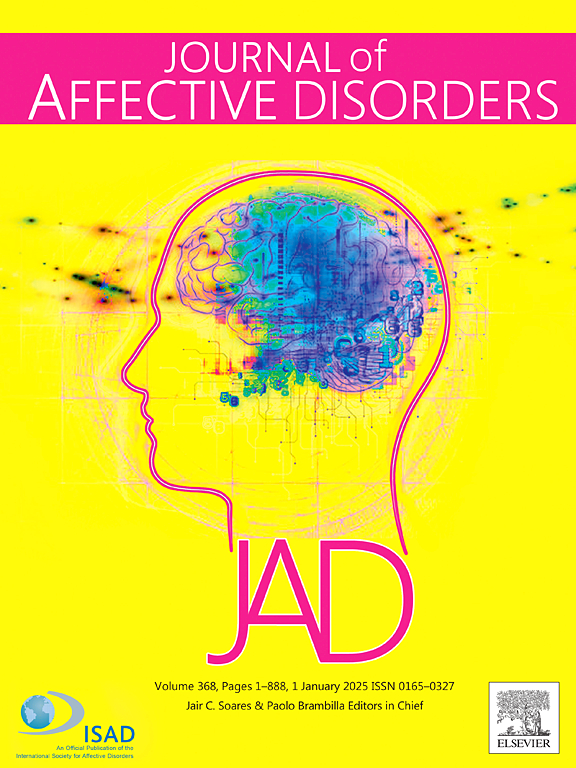生活方式及家庭环境因素对香港学龄前儿童心理健康问题的影响
IF 4.9
2区 医学
Q1 CLINICAL NEUROLOGY
引用次数: 0
摘要
背景和目的同时考虑生活方式和家庭环境因素对心理健康问题(MHPs)影响的现有研究,特别是在学龄前儿童中,是有限的。本研究旨在探讨生活方式和家庭环境因素与学龄前儿童MHPs、外化问题(EPs)和内化问题(IPs)的关系。方法本研究于2020年至2022年进行,涉及1926名学龄前儿童。评估MHPs、EPs和ip以及睡眠时间、睡眠潜伏期、娱乐屏幕时间、教育屏幕时间、亲子娱乐和学习活动等因素。采用线性和逻辑回归分析探讨这些因素与MHPs、EPs和IPs之间的关系。结果平均睡眠时间为9.94小时/天,平均屏幕时间为2.53小时/天,42.6%的学龄前儿童睡眠潜伏期超过20分钟/天(平均年龄4.39岁,其中49.1%为女性)。调整分析显示,亲子娱乐活动减少、睡眠潜伏期延长和娱乐屏幕时间过长与MHPs、EPs和IPs升高有关(β: 0.05 ~ 0.20, p <;0.05)。周末睡眠时间每天10小时、睡眠潜伏期每天20分钟、教育屏幕时间每天30分钟被确定为MHPs、EPs和IPs的危险因素,调整后的优势比为1.32 ~ 2.32 (p <;0.05)。结论幼儿生活方式和家庭环境因素分别与MHPs、EPs和IPs相关。确保充足的睡眠时间,避免每天睡眠潜伏期超过20分钟,减少娱乐屏幕时间,将教育屏幕时间限制在每天30分钟,以及增加亲子互动可能有助于最大限度地减少心理健康问题。本文章由计算机程序翻译,如有差异,请以英文原文为准。
Influence of lifestyle and family environment factors on mental health problems in Hong Kong preschoolers
Background and aims
Existing studies that simultaneously consider the effects of lifestyle and family environment factors on mental health problems (MHPs), particularly in preschoolers, are limited. This study aims to explore lifestyle and family environment factors associated with MHPs, externalising problems (EPs) and internalising problems (IPs) in preschoolers.
Methods
This territory-wide, school-based study conducted from 2020 to 2022 involved 1926 preschoolers. MHPs, EPs, and IPs and factors such as sleep duration, sleep latency, entertainment screen time, educational screen time, parent-child recreation and learning activities were assessed. Linear and logistic regression analyses were used to explore the relationships between these factors and MHPs, EPs, and IPs.
Results
The average sleep duration was 9.94 h per day, average screen time of 2.53 h per day, and 42.6 % experienced sleep latency exceeding 20 min per day among preschoolers (mean age: 4.39 years, 49.1 % female). Adjusted analyses showed that decreased parent-child recreation activities, prolonged sleep latency and excessive entertainment screen time were associated with increased MHPs, EPs, and IPs (β: 0.05 to 0.20, all p < 0.05). Weekend sleep duration of <10 h per day, sleep latency of >20 min per day, and educational screen time of >30 min per day were identified as risk factors for MHPs, EPs, and IPs, with an adjusted odds ratio ranging from 1.32 to 2.32 (all p < 0.05).
Conclusions
Preschoolers' lifestyle and family environment factors are associated with MHPs, EPs, and IPs respectively. Ensuring adequate sleep duration, avoiding sleep latency exceeding 20 min per day, reducing entertainment screen time, limiting educational screen time to 30 min per day, and increasing parent-child interactions may help to minimise mental health problems.
求助全文
通过发布文献求助,成功后即可免费获取论文全文。
去求助
来源期刊

Journal of affective disorders
医学-精神病学
CiteScore
10.90
自引率
6.10%
发文量
1319
审稿时长
9.3 weeks
期刊介绍:
The Journal of Affective Disorders publishes papers concerned with affective disorders in the widest sense: depression, mania, mood spectrum, emotions and personality, anxiety and stress. It is interdisciplinary and aims to bring together different approaches for a diverse readership. Top quality papers will be accepted dealing with any aspect of affective disorders, including neuroimaging, cognitive neurosciences, genetics, molecular biology, experimental and clinical neurosciences, pharmacology, neuroimmunoendocrinology, intervention and treatment trials.
 求助内容:
求助内容: 应助结果提醒方式:
应助结果提醒方式:


